#it’s called linguistics
Text
calling my lover "mine" but not in the way that my toothbrush or notebook are mine, mine in the way my neighborhood is mine, and also everybody else's, "mine" like mine to tend to, mine to care for, mine to love. "mine" not like possession but devotion.
#nonbinary love#nblnb yearning#nb4nb#nblnb#wholesomeposting#yearning hours#ive been thinking about how some languages dont have a possessive tense#so you dont say “i have a thing” but rather “a thing is by me”#and like im not usually one for psycho linguistics and like critical thoughts etc etc etc#but i really like the framework of responsibility/commitment rather than ownership#i think about this mostly in terms of ecology#and relation to land#but i also love it as it applies to language shared between lovers#like i LOVE calling them mine or for them to call me theirs#but i'm also nonmonog and that was kinda weird to square for a while#and it clicked one time when i was talking about my neighborhood and i was like well#when i say my neighborhood or my city it's understood i'm not taking it away from anybody else#its understood i just mean the city where i live#so why cant we apply the same to lovers?#mine in the way i want to show up for you again and again#ok#done now
98K notes
·
View notes
Text
kind of obsessed with the conlang invented by 12th century composer and mystic hildegard von bingen. she called it lingua ignota and just sort of never explained why it exists or what it’s for? like. girl. why did you do this
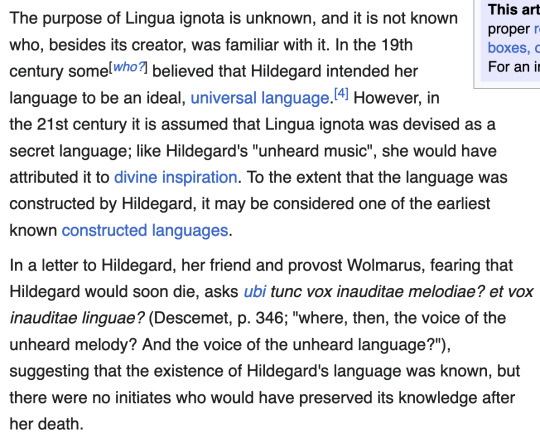


in case you're wondering what was up with her, like, in general, she was an abbess who was (1) politically influential, (2) chronically ill, and (3) plagued by visions.
but like seriously girl WHAT was the conlang for. TELL ME
#hildegard von bingen#did u know theres a bardcore artist called hildegard von blingen?#cw religion /#shaoniposting#conlang#linguistics#history
5K notes
·
View notes
Text
what i like especially about the pronouns in the goblin emperor is that this language doesn't just have the T-V distinction (aka informal vs. formal second-person pronouns, in this case 'thou' vs. 'you'), it also has informal and formal first-person pronouns. having BOTH of these distinctions in the same language lets you fine-tune your tone by mixing and matching. with only one axis of formality, when you use informal pronouns, are you being familiar in an intimate way, or in an insolent or dismissive way? when you use formal pronouns, are you being polite or standoffish? you can't tell just from the pronouns; there's ambiguity. but a language where you can use a formal first-person pronoun in the same sentence as an informal second-person pronoun allows you to distance yourself (via the formal first) while also being familiar (via the informal second), thereby achieving the conversational tenor known to linguists as Fuck Thee Specifically.
#just kidding i don't know what linguists call that tenor. or any tenors. i'm not totally positive what a tenor even is#but i can't let that stop me from writing a jokey post on tumblr dot com#register is a very interesting area of linguistics that i know very little about#so i'm probably revealing the depths of my vast ignorance here to all the sociolinguists who surely hang on my every word#but i've always thought of the formal/informal pronoun thing as being about two things: intimacy-distance & rudeness-politeness#and of course you can usually tell from context whether a formal pronoun is meant to indicate distance or politeness#(plus distance and politeness are related to each other (to various degrees depending on culture))#but it seems like it would be cool to have a built-in alignment chart of sorts just for pronoun combos#instead of prep jock nerd goth...why not try intimate self-effacing polite superior?#the goblin emperor#pronouns#register#sociolinguistics#my posts#f#anyway i know i said i wasn't going to reread the goblin emperor...but guess what. lol#and i edited my tags on that earlier post but fyi the language DOES distinguish between plural and formal singular pronouns#i had said i thought it used the same pronouns for plural and formal but i just wasn't paying close enough attention#so anyway i just reread the part where maia is talking to setheris in formal first and informal second#and you can see setheris going ohhh shit. oh shit oh shit oh shit#i'm in biiiiiig trouble#you sure are dude. that's the Time to Grovel signal#it's interesting because at the very beginning of the book when i first saw the formal first used i just thought it was the royal we#because i knew the main character was supposed to be royalty#but then EVERYONE was doing it. so it's not the royal we it's just the formal we#however. this does make me realize that the way the royal we would function in a language that retains the t-v distinction#is the same way i'm describing here. it's just reserving that particular tone (i'm better than you and am displeased with you)#for royalty only. which makes sense given royalty's whole deal
816 notes
·
View notes
Text
If you need help practicing pronouns, try using the pronouns you struggle with on your pets!
Animals have very little understanding of pronouns and human gender. They won't care if you use he, it, she, xie, bun, literally whatever - they only care about you and their food. They'll be fine! However, your loved ones will appreciate your effort in using pronouns, and using them properly. It's a win-win situation!
#trans#transgender#lgbt#lgbtq#ftm#mtf#nonbinary#ally advice#and honestly it's you learning more about linguistics which directly benefits you as well!#my cat is not a girl cat or a she like - those are human concepts of gender. she's whatever she Is.#i'll call her a boy cat or a he/him or whatever like she doesn't fucking care#she barely cares when i call her name (which i KNOW she knows#(and like nobody but her vet even needs to know. which i do take her to the vet and she's healthy and i love her so so so so so much <<3)
840 notes
·
View notes
Text
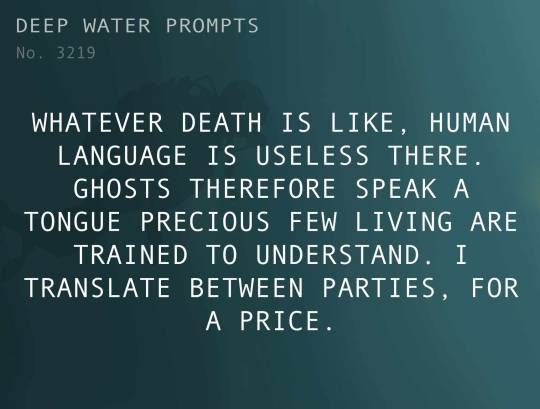
Text: Whatever death is like, human language is useless there. Ghosts therefore speak a tongue precious few living are trained to understand. I translate between parties, for a price.
#creative writing#writing prompts#death#ghosts#language#translation#someone with a translation/linguistics background please write this and call it ‘the dead speak’
195 notes
·
View notes
Text
OH PHIL BEING FULL ON INFODUMPING ABOUT LINGUISTICS THIS IS EVERYHING TO MEEEEEEE
#I LOVE THIS SHIT#I LEARNED LIKE A TINY AMOUNT I KNOW ABOUT LINGUISTICS BC I GOT OBSESSED WITH CONLANGS A WHILE BACK#YEAH CALL ME A LABIODENTAL FRICATIVE#dan and phil#phan
257 notes
·
View notes
Text
Because there's an eclipse, in latin class my teacher had us translate all these old Roman dudes thoughts and shit on eclipses and incase you didn't know they filled a basin with oil or tar so they could see the reflection of the eclipse and study it, or just watch it like normal because they were also obsessed like we are
#latin#language#eclipse#school stuff#high schoolers#teenagers#school#high school#rome#philosophy#oil and tar#its cause they wouldnt ripple#learning#learnsomethingneweveryday#linguistics#facts#fun facts#roman dudes#it was called like “questions about nature”#translation#we kinda failed at that part of class tho#solar eclipse
109 notes
·
View notes
Text
Hello! Here is data on point of view distribution across characters in The Dreamer Trilogy (which I will abbreviate as TD3) as a follow up to my TRC data from last year (viewable here). A rather long-winded discussion of the data, methods notes, and some supplemental figures and tables are under the cut. As it was not possible to include all values and stats in this post (nor in the alt text for image IDs), my spreadsheet can be viewed by clicking here,




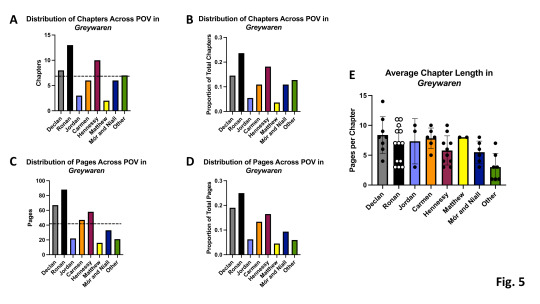
This project quantifies and visualizes the distribution of chapters and pages in the books of TD3 across characters from whose POVs the story is told. I didn’t have much of a hypothesis going into data collection/analysis, especially not like I did for the TRC data, but I did expect to see Ronan’s POV having the most chapters and pages for the entire series, given the fact that he is the most central of the protagonists. I don’t think page time is the be-all-end-all for a character’s importance, of course, but it is still interesting to consider how spending more time from certain perspectives affects the perceived narrative. I won’t get much into that aspect of analysis in this post, but if anybody would actually like to discuss that, I’d love to!
Results (and Interpretation):
TD3 consists of 173 chapters and 1184 pages (using the U.S. hardcover editions), making the average chapter 6.84 pages. The longest chapter is 16 pages, and the shortest is 1 page.
Figure 1A: The average chapter in Mister Impossible (MI) is considerably longer (9.26 pages) than the average chapter in Call Down the Hawk (CDTH) (6.00 pages) and in Greywaren (GW) (6.40 pages), which makes sense as MI has just 38 chapters while CDTH has 80 and GW has 55 (see Fig. 2). To me, the effect of the longer chapters (and therefore extended time with the current POV character) makes the various POVs feel more temporally distant from one another- not in a narratively incoherent way, but in a way that echoes the sense of isolation experienced by dreamers and weaponized by Bryde as he tries to convince Ronan and Hennessy to abandon their loved ones.
Figure 1B: Chapter length is fairly consistent amongst POVs across the series. Matthew has the longest average chapter length (8.40 page) over a small set of chapters (5 total)- his character development (as told from his own POV) is limited to a small number of instances, which may have stretched his chapters a bit longer. The 'Other' category has the shortest average chapter length (5.13 pages) (Fig. 1B); it includes the typically short chapters from witnesses of Visionary explosions/aftermath (Mags, Dabney) as well as Nathan's manifesto excerpts. (As a side note, I've described the chapters depicting memories from the Barns as 'Mór and Niall.' These chapters do not collectively portray an equal balance of their POVs, but this was the simplest way to categorize them.)
Figure 2A-B: These graphs are representations of chapter distribution across POVs in TD3 in terms of chapter count (2A) and proportion of total chapters (2B). Some observed trends include Declan's proportion of total chapters remaining quite constant throughout the series, Ronan's decreasing, Hennessy's proportion of chapters nearly doubling from CDTH to MI (and staying at a similar proportion to MI in GW), and Jordan's proportion following an opposite trend (consistent proportion in CDTH and MI, followed by a more than 50% drop in GW). Carmen's proportion of chapters also declines after CDTH.
Figure 2C: This graph compares total chapters per character POV over the entire series. We can see that the largest proportion of the series is told from Ronan's POV (53 chapters, or 0.306 of all chapters). To put that in perspective, Hennessy has the next highest number of chapters (26, or 0.150 of all chapters), which is just under half the number of Ronan's. If all characters had an equal number of chapters from their POV (including the miscellaneous POVs as one category labeled Other), they would each have 21.6 chapters, represented by the horizontal dashed line; Declan, Jordan, Carmen, and Hennessy all have chapter counts relatively close to this number.
Figure 2D-E: These are representations of page distribution across POVs in TD3 in terms of page count (2D) and proportion of total pages (2E). Trends are similar to those depicted in 2A-B, but 2E does make Declan's increased proportion of page time in GW salient.
Figure 2F: This graph compares total pages per character POV over the entire series. The dashed line shows that if each character (plus the Other category) had equal page time in the series, readers would spend 148 pages with each POV. Again, page data is similar to chapter data, but comparing graphs 2C and 2F gives a clear visual indicator that Jordan's chapters (on average, 8.11 pages) are longer than Carmen's (on average, 6.08 pages), since Carmen has visibly more chapters in 2C yet nearly the same number of pages as Jordan in 2F.
Figure 3: Figure 3 shows distribution of chapters (3A-B) and pages (3C-D) in CDTH, as well as average chapter length for each character POV (3E). An equal distribution of chapters would have been 13.3 per character, and an equal distribution of pages would have been 80.0 per character. The 'Other' category included chapters from the perspectives of Lock, Breck Myrtle, Shawna Wells, Jason Morgenthaler (and Lin Draper, briefly, in the same chapter), Mags Harmonhouse, and Dabney Pitts. Carmen's average chapter length in CDTH (4.67 pages) is the lowest single-book average for character POVs appearing throughout the entire series. (Nathan's average chapter length is just 1.00 [Supplemental Figure 2], yet his POV only appears in GW via his manifesto excerpts, and while I have attributed these chapters to his POV, I interpret the POV as actually ambiguous. As with Kavinsky's text in TDT, it's not absolutely certain if we are reading from the writer or the reader's perspective [although in TDT, due to the lack of Kavinsky POV elsewhere, it's probably the latter]).
Figure 4: Figure 4 shows distribution of chapters (4A-B) and pages (4C-D) in MI, as well as average chapter length for each character POV (4E). An equal distribution of chapters would have been 5.43 per character, and an equal distribution of pages would have been 50.3 per character. The 'Other' category included two chapters, both with what I deemed omniscient narration. Declan had the shortest chapters in MI (8.20 pages), and Jordan had the longest (11.4 pages, the longest average for a character for a single book in this series).
Figure 5: Figure 5 shows distribution of chapters (4A-B) and pages (4C-D) in GW, as well as average chapter length for each character POV (4E). An equal distribution of chapters would have been 6.88 per character, and an equal distribution of pages would have been 44.0 per character. The 'Other' category included Nathan's manifesto excerpts (3 chapters), 1 chapter from Liliana's POV, and 3 other chapters with omniscient narration. While Ronan never has the longest chapters, his chapters are shorter relative to other POVs in Greywaren, perhaps as a result of the way his chapters are written during his time asleep/in the sweetmetal sea. I have not yet investigated whether chapters tend to be longer while characters are awake vs asleep or dreaming, but that's something that could be measured from the existing data in the spreadsheet! There is also a dramatic drop in Jordan's POV time in GW compared to the previous two books, perhaps because of her increased divergence from Hennessy and desire to establish a life that follows her own narrative.
Other findings: A major difference I noted between TRC and TD3 was the lack of split chapters in TD3. In TRC, the data analysis was made slightly complicated by having to account for the fact that a non-negligible number of chapters would make a distinct and discrete switch between POVs partway through. While I did not observe this in TD3, I did encounter more ambiguous/nebulous POVs as I previously mentioned. The increased presence of omniscience in the trilogy, for me, contributed to the increased sense of scale and stakes compared to TRC. This increased continuity amongst POV (not amongst core/recurring POV characters, but amongst groups of characters/communities depicted in the omnisciently narrated chapters) also contributed to a sense of dissolution of barriers and identities, perhaps thematically in line with Ronan's character development and increasingly holistic perspective of both his humanity and otherworldliness (although Ronan is not necessarily featured in these 'boundary-breaking' chapters). I also briefly looked at occurrences of back-to-back chapters from the same POV; this happens most frequently for Ronan in all three books, mainly in CDTH, and sometimes featuring a dreaming chapter directly before an awake chapter (or vice versa) in immediate succession. Declan (MI), Carmen (CDTH), and Jordan (CDTH) all have a pair of back-to-back chapters at some point in the series; Hennessy has 2 (MI, GW).
Conclusions: In all honesty, despite this project being quite fun and fulfilling and of course, worth doing, I do not think I have any particularly insightful conclusions about the data beyond what I've already discussed. Ronan took up the largest share of the chapters and pages as expected, although I am not sure I expected this to be true by such a large margin. I also was surprised that Declan did not have more chapter/page time, but it is possible that his notable inclusion in chapters from other characters' POVs increases his prominence in the series (and I suppose this is probably true for all characters who frequently appear in chapters outside their perspective). As with TRC, the number of POVs expands as the series develops, often with the effect of increasing the scope of the story's implications, and perhaps, more importantly, showing the story from additional angles that contextualize and/or distort narrative established by other characters' perspectives. I hope you've enjoyed exploring the data as I have, and those interested in my methodology may continue reading below!
Methods:
Data collection was straightforward in the sense that I simply counted the pages in each chapter and then assigned each chapter to a character based on the POV represented. The POV character assignment was more difficult than it was for TRC, as TD3 has more omnisciently narrated chapters, which in itself is easy to categorize, but they often zoom in on or are 'biased' towards the experience of a particular character, so I had to make some decisions as to what, for me, constituted sufficient focus on a character’s internal narration and expression vs. omniscience. In the spreadsheet, I took notes on these more subjectively driven decisions. Again, you can view it here! It also contains data on whether the chapter is from an awake or dreaming POV, and has the first lines of each chapter, among which are some fun repeating patterns.
For bar graphs with dots, each dot represents a single chapter. You may also notice that the graphs are missing p-values from statistical tests this time around! This is because, since completing the TRC data, I’ve realized that such measures of uncertainty re: significant differences are not appropriate for my dataset, which is not a sample representing a population, but rather a complete group of chapters (so parametric tests are not necessarily helpful or valid). However, I still like to run the tests for my own amusement and to see what the results would be if this were a dataset for which ANOVA and contingency tests were appropriate, so I have standard deviation bars on the graphs where calculable (but no standard deviations in the text of the results section for legibility) as well as the p-values in tables at the end of this post for anyone also curious. I did still calculate the numbers of chapters and pages that would represent an equal distribution across POV characters, which are represented by the dashed lines on the relevant figures. I think this is helpful to visually gauge 'over-representation' and 'under-representation' of character POVs.
Below are the supplemental figures showing all character POVs rather than lumping some together in an 'other' category. The MI data in figure 4 is not expanded below because the chapters designated as 'other' were omniscient and thus would have remained in the same category.
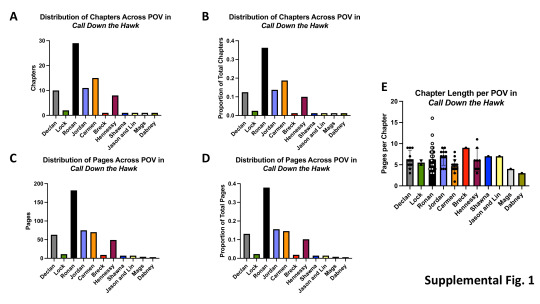
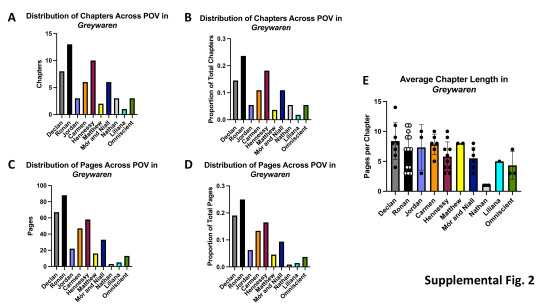
And finally, here are the omitted p-values, if you'd like to pretend along with me that all the chapters in TD3 are not a complete set but rather a representative sample of a greater population of chapters that's out there in the universe. :) When I give a p-value below the 0.05 threshold but still write 'no significant differences amongst any combination of characters, I mean that the p-values generated for the comparisons between each possible pair of characters were all above 0.05, which are distinct from the overall p-value generated from the ANOVA.


#the dreamer trilogy#call down the hawk#mister impossible#greywaren#ronan lynch#declan lynch#jordan hennessy#carmen farooq-lane#long post#rchl#now onto more qualitative/linguistic things! xoxo
102 notes
·
View notes
Text
Call for Linguistic Study Participants
Are you a Native English speaker? (of any dialect/variety)
Are you over 18 years old?
Do you want to help my best friend with their MA study?
Can you spare 20 minutes to do an online experiment where you learn some words in a new language? (preferably on a Windows laptop)
For more information follow this link:
please also reblog this if you can!
412 notes
·
View notes
Text
AMAZING NEWS BESTIES

#LETS FUCKING GOOOOOOOOO#art history linguist cowboy my love of my life!!!!!!!!#the librarians#jacob stone#the librarians the next chapter#tl:tnc#i called it when they anounced the show okay we been knew
70 notes
·
View notes
Text
God the absolute urge I have to make Owen use Cockney rhyming slang... ESPECIALLY as the DMA. Imagine, the DMA is talking about how many people he's killed and he just throws in "brown bread" and Von Nazi is just like ???????? with waffle fries?????
#is this coherent#yeah this is just me trying to cope with not being able to make Owen use northern slang#what i would give to hear that man say the word owt...#anyway if we're going with the cockney rhyming slang thing that means The Staircase Scene is called The Apple And Pear-case Scene. which.#its not very dramatic...#this is such a self indulgent linguistics post im sorry#spies are forever#saf#owen carvour#agent owen carvour#tin can bros#tin can brothers#tcb
50 notes
·
View notes
Text
Fun fact: in Anishinaabemowin, the term for a cat purring is "nagamo gaazhagehns" / "nagamo biizhehns" / " nagamo boozhehns" (different dialects have varying words/spellings for a house cat)
But the main thing is that "nagamo" is the verb for "he/she/that one sings"
Cat purring in Anishinaabemowin is essentially called "cat singing"
#anishinaabemowin#ojibwemowin#ojibwe#anishinaabe#indigenous languages#the words for cat also are fun#gaazhagehns comes from the verb 'gaazhage' which means 'he/she/that one eats greedily or is gluttonous#so gaazhagehns translates roughly to 'little greedy eating one'#and boozhehns/biizhehns are the diminutive versions of the the word for a lynx (bizhiw) because#--that was the example of a feline that existed in our language/world when domestic cats were introduced to us#so we just called them 'tiny/baby lynxes'#i love anishinaabemowins maliability and ability to just create words to address new things#nish tag#linguistics#original posts#indigenous tag
228 notes
·
View notes
Text
GROMSKO - A Pronunciation Guide
Suave Sobiesław (It rhymes. Get it?)
Sobiesław - Soa - Beh- swav
O like Oat. ł is a W like Web. W is pronounced as a V sound.
Kosciuszko - KOSh-CHews-skO
Kos like Gossip.
C iu-s like Check and Useless with a partially voiced S/Z.
Sko like Go.
Notes:
Voiced and unvoiced referring to how involved your vocal cords are. A good way to understand this is try switching between F - V and S - Z.
V in many central and eastern European countries sometimes sounds like a 'voiced F' .
(I will not be making an accent/speech guide as I have for König as I don't speak Polish and feel it's not my place. If you are Polish and have any feedback or would like to help me work on such a post feel free to reach out.)
"ZA HONOR I OJCZYZNĘ!"
Now go, be free, have fun with everybody's favourite beefy Polak.
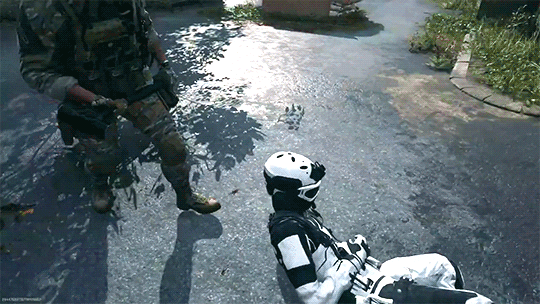
#Fr tho what are they feeding him?#gromsko#How can I get that chunky 👀#sobiesław kościuszko#His Bubcia feeding him plenty of Kiełbasa and Pączki for sure#'MASTER OF STEALTH' with a sledgehammer and an RPG#He's just built different#linguistics#call of duty#cod modern warfare#polish language#specgru#cod mw2#languagelearning#pronounciation#loth-moth resources#sobieslaw gromsko kościuszko#Polski#langblr
90 notes
·
View notes
Text
I don't know how to make this thought coherent, so bear with me people, but. I think ritsu calling shou "suzuki" instead of "suzuki-kun" says a lot about their relationship. ritsu is extremely consistent and polite with his use of honorifics, even with people he doesn't like that much (reigen is always reigen-san, for example)
but shou is always "suzuki," he never gets his proper honorific. this might be a stretch, but I think it fits into what I've thought about their relationship in the past, which is that shou gives ritsu the opportunity to drop the perfect kid act. him using everyone's polite honorifics might be good etiquette, but it also might be him creating distance between himself and others while wearing a polite mask. with shou, he doesn't need to bother with that. they met by beating the hell out of each other for fuck's sake, etiquette is out the window here
but while him dropping honorifics might be rude in other cases (the "NO HONORIFIC??" bit with hoshino in that one omake comes to mind) I don't think it is here. I'd forgotten until doing this reread, but ritsu refers to shou as his friend really easily. like, they've known each other for maybe a full day, and they were enemies before that, but when looking up at the cultural tower, he tells mob "my friend is up there!"
so I think him just calling him suzuki is actually a sign of him being close with shou. no bullshit, no using honorifics to maintain a polite image or to intimidate or to impress. he's just being direct with him, because shou isn't someone he has to put up a front around
#mp100#this is not as coherent as I would like but hopefully it makes sense#ritsu kageyama#me? analyzing the way characters talk to each other? it's more likely than you think#linguistics brain goes brrrrrrrr#anyway. it was wild on reread for me to realize how easily he calls shou his friend#I had forgotten about that!#they've only known each other for a day but he's worried because his friend is up there in that tower!!#shou and ritsu's friendship is v important to me#shou is someone ritsu can be real with#and they understand each other better than most would#it's good for both of them
313 notes
·
View notes
Text
I've noticed a pattern so I figured I'd run a poll on it. I wish I could be more granular with the locations but the ones I picked are based on the pattern I've been seeing. I'd love to hear explanations for why you do or do not use it, as well!
#poll#politics#ish#world politics#language poll#linguistics poll#linguistics#language#I THINK????#i personally don't say USAmerican#its the only country with america in the name#and i really sincerely doubt you'll get away with calling anyone else from the american continents an american irl
34 notes
·
View notes
Text
"use commas" this "learn how to spell" that. you fools. the very core of linguistics is the change that you so despise on account of lacking any sort of knowledge or foresight. you imbeciles. we the linguists laugh at your little commas and dots that you throw around in your playpen. you think it matters? you think any of this matters? the only thing you should even slightly care about is if you can understand or interpret the core of the message. you hold up the punctuation system as you do the values of the past, thinking it sacred, much like a false idol. you will never be free if you dont stop policing the victimless crimes we've made up. you will never ascend.
#linguistics#language#mepost#every time someone fixes a spelling issue that isn't necessarily relevant a linguist loses their wings#we call your behavior prescriptivism and laugh at you behind your back by the way#this isn't to say let's not teach kids the official spelling rules#i just mean if someone's shitposting it's unnecessary#shitpost#i'm rambling#love u all#are you still here reading this#check out my other posts and make me feel loved#hey have you guys ever heard that song 'would?' by alice in chains?#it sounds like it's a 2000's videogame soundtrack dont you think?#i just think it's neat#oh god are they problematic#i should've googled this#well i guess let me know if they are#hey does anyone wanna be friends?#it gets lonely out here in the tags#i mean message me?#i cant promise you the best skills in the art of conversation#but i am known to hold one or two in my time#the conversations i mean#anyways thats all
397 notes
·
View notes